History of the McCaskey High School Campus
 In recent years, it has not been uncommon to see McCaskey students and staff wearing a T-shirt designed by McCaskey Social Studies teacher Matt Coonan. The shirt says simply “I’McCaskey.” What does it mean to be McCaskey? That question is answered (at least in part) by another T-shirt Coonan designed, which says, “Tornado Pride: 1 school, 2 buildings, 38 languages, 50 nationalities, 3000 students.” These words may come as a surprise to alumni who have not visited the campus for many years. McCaskey High School has grown substantially in the acreage it occupies, as well as the diversity it represents. However, diversity was the guiding principal when Lancaster City decided that boys and girls would attend high school under one roof in 1938.
In recent years, it has not been uncommon to see McCaskey students and staff wearing a T-shirt designed by McCaskey Social Studies teacher Matt Coonan. The shirt says simply “I’McCaskey.” What does it mean to be McCaskey? That question is answered (at least in part) by another T-shirt Coonan designed, which says, “Tornado Pride: 1 school, 2 buildings, 38 languages, 50 nationalities, 3000 students.” These words may come as a surprise to alumni who have not visited the campus for many years. McCaskey High School has grown substantially in the acreage it occupies, as well as the diversity it represents. However, diversity was the guiding principal when Lancaster City decided that boys and girls would attend high school under one roof in 1938.
Prior to the construction of J.P. McCaskey High School, 10th, 11th, and 12th grade boys attended Lancaster Boys High School at the corner of West Orange Street and Mulberry Street, now Robert Fulton Elementary School (Among the final graduates of Lancaster Boys High was WWII Major Richard Winters ’37, the inspiration for the book and HBO mini-series Band of Brothers). Meanwhile, the girls attended Stevens High School, at the corner of West Chestnut Street and Charlotte Street, now the Residences at Stevens School. Boys and girls would now be taught together at the new coeducational building, fittingly named after a beloved and dynamic local educator, John Piersol McCaskey (1837-1935). The construction was paid for mostly by the federal government and was the largest Lancaster County building funded by President Franklin Delano Roosevelt’s New Deal, an economic relief movement of the Great Depression.
Construction got underway for the new state-of-the-art high school in 1934. Among the country’s first schools with a modern Art Deco design, its unusual H shape provided for the division of many areas of study: language, social studies, science, commercial, vocational, industrial arts, home economics, art, music, and physical education. Many tax-paying citizens objected to this expensive new structure, questioning its safety for occupancy. One Lancaster church leader even denounced the project from the pulpit, saying in a sermon that “anxious parents cannot be but worried over what might happen to their children in that building if it is unsafely built.” As a result of the controversy, engineering consultants from outside of Pennsylvania were summoned to Lancaster to investigate the building. They affirmed its safety for occupancy, but the plan to build a trolley line along the street in front of the building was scrapped.
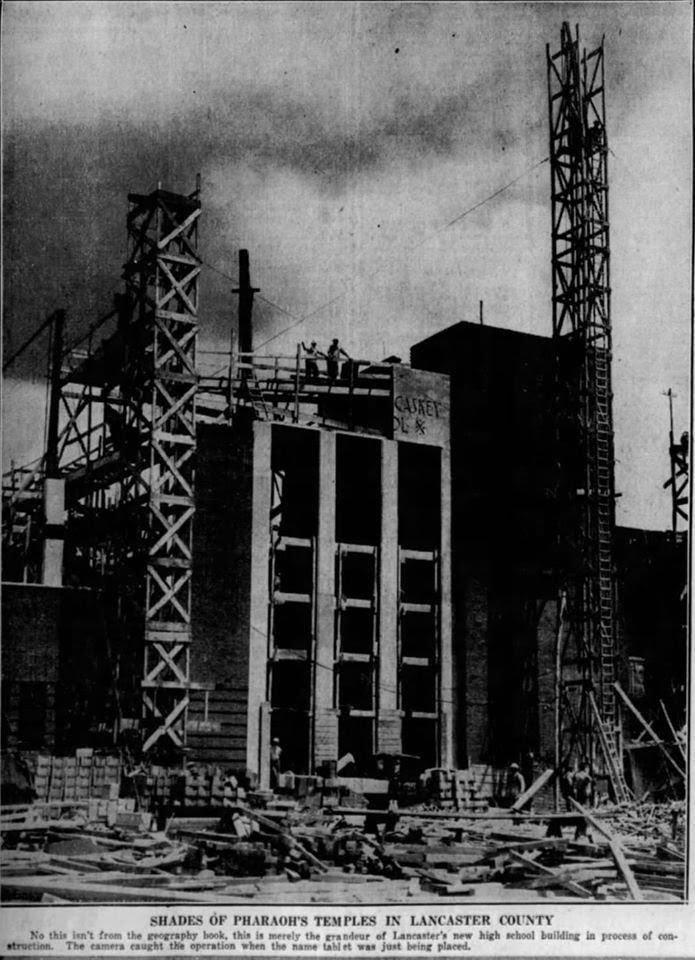
J.P. McCaskey High School under construction. Clipping provided by Cynthia Douts Roth
Costing a total of $1,400,000, including furnishings, the new school at 445 N. Reservoir Street occupied 2 ½ acres of a 35-acre tract of land. Numerous trees were planted on the campus to memorialize local artists. Holding 81 classrooms, the building itself was said to have a capacity for 2,500 students. The main foyer, lobby, and auditorium were designed to invite community events, resembling a grand public building. The ceiling of the foyer was gold leaf, and St. Albans red marble from Vermont was used in the foyer walls and stairwell to the second floor. An ornamental frieze made of sandblasted linoleum ran along the top of the lobby wall. Seating 1,840 people, the auditorium was the largest in the area, and its 90-foot proscenium stage was the widest high school stage east of the Mississippi River. Not long before his death in 1987, the primary architect for the project, H.C. Kreisle, an associate in the firm of Henry Y. Shaub, stated, “Among the many school buildings that we did, the one that I am most proud of having played a key part in planning is McCaskey High School.”
At the time of McCaskey’s founding, Commencement was held twice a year, with a “mid-year” class graduating in January, and another group of seniors graduating in June (This schedule ended with the graduation of the Class of Mid-1940, and, from then on, commencements occurred only in June). In his address to the Class of Mid-1938, the first class to graduate from McCaskey High School officially, and the only class to do so having never attended school in the new building, McCaskey’s first principal, Dr. Benjamin B. Herr, stated: “Someone has said that when you see the railroad station you know what the railroad company thinks of the community, when you see the post office you know what the government thinks of the community, but when you see the school buildings you know what the people think of themselves. Lancaster is proud of its boys and girls.”
On February 3, 1938, students from Boys High and Stevens carried textbooks and personal belongings to the new high school where they were given a tour of the building. Many of them returned the next day with library books from their former schools. Over the course of three days –
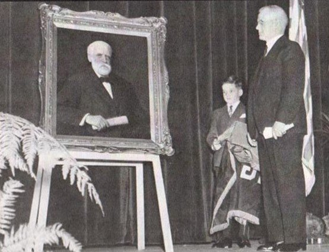
J.P. McCaskey’s son, Walter Bogardus McCaskey (right), and great-grandson, James Douglas McCaskey, unveil a portrait of their relative at the J.P. McCaskey High School Dedication
Saturday, February 5, Sunday, February 6, and Monday, February 7 – nearly 200 students led more than 30,000 visitors on tours of the new building. On the final day of the open house, 1,900 students and 85 faculty and staff members met at McCaskey for the first day of instruction. The diverse curriculum specialized in college preparatory, commercial, general, vocational, and special education subjects. One of the first safe driving courses in the nation, featuring dual-control cars, began that day at McCaskey. Nearly three months later, on May 3, 1938, the official dedication of the school was held. A future member of the McCaskey Class of 1947, James D. McCaskey, unveiled an oil portrait of his great grandfather, John Piersol McCaskey (This portrait now hangs in the main office at J.P. McCaskey High School). The following month, 274 students graduated in the June Commencement Ceremony. Among the members of the June 1938 class were future Olympic sprinter, Henry Norwood “Barney” Ewell, and the school’s first valedictorian, Franklin J. Schaffner, who would win the Best Director Academy Award in 1970 for Patton.
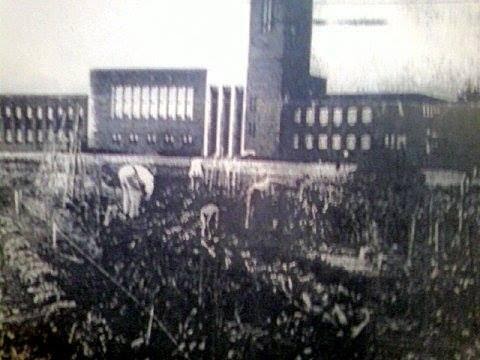
The Victory Garden on Victory Field. Photo provided by Cynthia Douts Roth
Just a year and a half after the building opened, McCaskey High School ranked as one of the five best high schools in Pennsylvania. Less than four years after it opened, America became involved in World War II. Upon the declaration of war, the entire student population joined in the war effort. Students collected books for the USO and the Red Cross, and enlisted in the armed forces. Shop instructors focused on preparing students for work in the defense industry and guided the construction of models used to educate military personnel. In January 1942, air raid drills began at the school. The school collected $229.80 by March of 1942 to help purchase an airplane propeller. Throughout the war, students continued to collect scrap metal, and 88 tons of scrap paper had been collected by June 1944. Plots of the large field across the street from the high school were made available to the local citizenry to plant “victory gardens”, a common means of confronting labor shortages and food rationing during the war. It was not long before the McCaskey victory gardens produced an abundance of vegetables. Now a grass-covered field lined with trees, it remains known as Victory Field.
Before the fall semester of the 1938-1939 school year, a subscription to the Vidette, McCaskey’s only school publication, included four monthly news magazines and a yearbook each semester. The format of the magazine was changed in September 1938 to a four-page newspaper published four times each semester. The yearbook was renamed the Citadel in 1949, then in 1950 the Echo (as it has been called ever since), while the newspaper retained the Vidette title. The Vidette began to broadcast a 15-minute weekly radio program beginning on January 29, 1949. This program was broadcast over station WLAN and continued for ten years (Later, McCaskey established WJPM Radio, which would become a live closed circuit morning television show, and then a pre-recorded program known as WMCC, referring to the “McCaskey Campus”). Beginning in 1949 and continuing for ten consecutive years the Vidette earned top ratings from the National Scholastic Press Association and other similar organizations. In 1956 the Department of Journalism of Pennsylvania State University named the Vidette the “best school newspaper” in the state.
When the school first opened, students of color represented 5 percent its population; fifty years later, 45 percent were students of color. These students came to McCaskey from approximately 30 different countries and language backgrounds. As a changing community resulted in a growing student body, extensive renovation and a rather large addition to the J.P. building began in the school year 1971-1972. Completed in June, 1974, the total cost of the entire project was set at $3,400,000. An addition to the building housed new physical education facilities with an entrance lobby and ticket booths, and a cafeteria. The large gymnasium area, with a seating capacity of more than 2,000 people could be divided into parts by folding doors. The massive new cafeteria could accommodate the students in two sections instead of the previous five shifts.
Another major construction project was conceived in 1991, when the School District of Lancaster embarked on an ambitious plan to prepare the next generation of Lancaster City youth for success. While the middle of the 20th century had seen a workforce populated mostly by unskilled workers, it was noted that by the year 2000, only 15% of jobs would be available to individuals without specialized training. A committee was formed to help usher McCaskey students into the new millennium prepared. The committee had two goals: 1) Every child who graduates from the School District of Lancaster will be prepared for some type of post-secondary education, such as college or technical school; or 2) Every child who graduates will be prepared to be successful in an entry level job in the workplace. As the year 2000 approached, it was also observed that fewer jobs would require individuals to work independently. High schools needed to begin training students to work well in teams. Therefore, it was decided that the McCaskey Campus would require a new facility—one that was designed around a team concept with state-of-the-art tools.
“There was a need for it,” remembers Carroll “Butch” Staub, former principal of the J.P. building. “We needed space. We needed technology. We needed updated classrooms.”
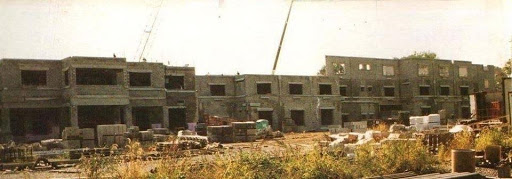
McCaskey East under construction
The groundbreaking for the new $28 million high school occurred in 1994, beginning a two-year construction period. Finally, on August 28, 1996, rising senior Esteban Rodriguez, President of the Class of 1997, took a pair of giant scissors to the red and black ribbon that cordoned off the main entrance of McCaskey East. Features of the new four-story McCaskey East building included a semi-circular instruction room, windows for natural light, greenhouses in the science department, patios off the cafeteria and art department, a gymnasium, and a beautiful state-of-the-art auditorium.
From September 1996 to June 1997, immediately following its dedication, “East” housed tenth, eleventh and twelfth grade students while J.P. McCaskey High School was undergoing its most recent renovation. Then in September of 1997, it began hosting freshmen and sophomores. For the first time, ninth-graders in the district no longer went to junior high school—now known as middle school. Middle schools now hosted sixth grade, which, in years prior, had been held in the elementary schools. Today, McCaskey East is no longer reserved only for 9th and 10th graders, but serves as one of two buildings on the McCaskey High School Campus, both of which offer instruction for grades 9-12.
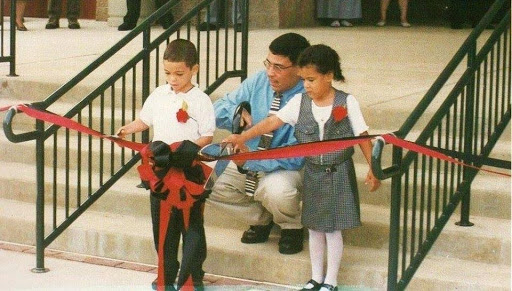
The ribbon-cutting ceremony in 1996, officiated by 1997 Class President Esteban Rodriguez, along with youngsters James Stewart and Chamele Batts.
The renovations of J.P. McCaskey High School included a 17,000-square-foot expansion. Much of the facility, including the lobby, remained architecturally true, while the renovations addressed the needs of increased technology and the specialized educational areas. All classrooms became air-conditioned. The original semi-circular orchestra room retained its tiers. Newly refurbished, it became the band’s large group instruction room. Even the original 1938 lockers, auditorium seats, and auditorium lighting were restored. At the hub of the school, a completely new media center was established featuring modern research technology and a 4,000-square-foot reading area. The center’s high ceilings and other features harmonized with the rest of the original building.
In 2001, the School District of Lancaster implemented a more targeted, personalized learning environment at the high school by creating Small Learning Communities (SLCs). SLCs focus on creating stronger student-teacher relationships by placing students into small schools within a school. All students are exposed to a rigorous core curriculum with the addition of elective classes specific to personal interest. This approach keeps students engaged while encouraging them to plan for their future. At the end of their eighth-grade year, students are able to choose from the following communities, each enrolling two to four hundred students who have the same team of teachers throughout their high school experience: Arts & Humanities, Public Leadership & Service, College Preparation & Partnerships, Career Connections, Honors/International Baccalaureate, McCaskey Institute of Technology (MIT), McCaskey School of Health Sciences, Vocational, Technical & Business, and the International School.
By the second decade of the 21st Century, a number of important changes occurred on the McCaskey Campus. In March of 2013, the School District of Lancaster approved the implementation of an Air Force JROTC program at McCaskey East. Up to 180 student cadets would have the opportunity to be instructed by retired Air Force officers in a curriculum focused on leadership and aerospace science. In the fall of that same year, McCaskey Social Studies teacher Gabriel Painton introduced Hooverville, which has become a highly anticipated annual event in which students set up tents on Victory Field to simulate homelessness, learn about the hoovervilles of the Great Depression, and hear lectures from local leaders combatting poverty and food insecurity. The following April, the Washington Post ranked J.P. McCaskey High School among the 20 most rigorous high schools in Pennsylvania on their list of “America’s Most Challenging High Schools.” The Post based this ranking on the high number of McCaskey students who attempted college-level exams. McCaskey was the only school in Lancaster County to make the list.
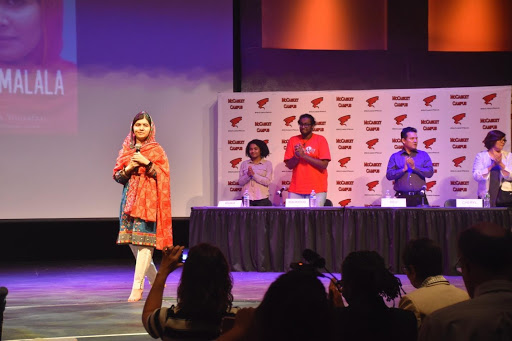
Malala Yousafzai on the J.P. McCaskey Auditorium stage.
As the McCaskey Campus continued toward the end of the decade, history was made on a couple of fronts. On Tuesday, April 11, 2017 the McCaskey Campus had a surprise visit from perhaps the most globally influential person ever to appear at the high school: the youngest winner of the Nobel Peace Prize, Malala Yousafzai. Drawn by the reputation of Lancaster City and its high school for diversity and the warm acceptance of refugees, Yousafzai told the crowd of 1,000 McCaskey students and community members, “I want to thank your school for being such a wonderful and amazing school.” Throughout the event, Yousafzai praised the “beauty” of the McCaskey Campus’s diversity. “It is an opportunity for you to learn,” she said, “because when you meet people from different communities, from different cultures, it broadens your mind, it expands your vision.” Following her talk, she took several questions from McCaskey students about how they could help her mission to ensure education for girls around the world. In keeping with Yousafzai’s vision for young women, McCaskey Athletics made history three years later, in March of 2020, by becoming the first school in Pennsylvania to start an all-girls wrestling team.
That same March, the danger of the global Covid-19 pandemic had begun to be felt in Pennsylvania. On Thursday, March 12, students went to school as if it were any other day, not knowing that it would be the last day of school for the year, and, for seniors, the last day of high school. The next day, Governor Tom Wolf announced that schools would be closed for two weeks. Before the end of those two weeks, the school closure was extended by another two weeks. Finally, on April 9, Wolf announced the cancellation of Pennsylvania schools for the remainder of the academic year. Among the losses felt at McCaskey was the cancellation of the spring musical, The Addams Family, which had been scheduled to open on March 19. McCaskey students continued their studies remotely from home.
The J.P. McCaskey High School Campus celebrated its 86th commencement virtually on Saturday, June 13, at noon. The ceremony, including live and pre-recorded elements was broadcast on WGAL-TV, Channel 8, and simulcast on Facebook, YouTube and UStream. In the final speech of the program, Associate Principal Luis Diaz told the Class of 2020:
“Recently we’ve all been thrown into a circumstance that, quite frankly, reminds me a lot of church . . . You are oftentimes told that church is not about the brick and the mortar, and the doors, and the windows, and the rooftop . . . but instead, it is the people that come together under one cause—a cause that steers you to make decisions based on your passions and priorities. These passions and priorities will then lead you to assume roles amongst the people that you surround yourself with . . . The changes you will make will affect the people around you and, in turn, become your individual successes, but more importantly, humanity’s successes . . . And when you run into challenges, and you will, always know we here at J.P. McCaskey High School are here for you. You will not be alone. You have never been alone.”
Then Mr. Diaz asked those watching from home to stand up and put their hand in the air:
“Repeat after me, I am a McCaskey graduate. Once a Tornado, always a Tornado.”
(Reprinted in part from Past is Prologue by Robert W. Broome, and from the dedication brochures for McCaskey East, 1996, and J.P. McCaskey, 1997.)
